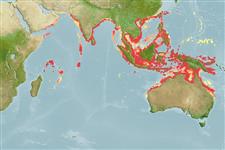>
Gobiiformes (Gobies) >
Gobiidae (Gobies) > Gobiinae
Etymology: Acentrogobius: Greek, a = without + Greek, kentron = sting + Latin gobius = gudgeon (Ref. 45335).
More on author: Valenciennes.
Environment: milieu / climate zone / depth range / distribution range
Écologie
marin; eau douce; saumâtre démersal; amphidrome (Ref. 46888). Tropical; 26°N - 27°S, 51°E - 135°W
Indo-West Pacific. Freshwater records from Madagascar by Pellegrin were based on juveniles of unidentified species (Ref. 4343).
Taille / Poids / Âge
Maturity: Lm ? range ? - ? cm
Max length : 18.3 cm TL mâle / non sexé; (Ref. 122101); poids max. publié: 51.60 g (Ref. 122101)
Description synthétique
Clés d'identification | Morphologie | Morphométrie
Épines dorsales (Total) : 6 - 7; Rayons mous dorsaux (Total) : 9 - 10; Épines anales: 1; Rayons mous anaux: 9. Characterized by pale grey body with five diffuse brown saddles along back; midside with 4-5 diffuse brown blotches; head and body with scattered white spots; presence of diagnostic greenish patch behind upper edge of operculum; rounded caudal fin; longitudinal scale series 25-26; scales absent on head except upper half of opercle and predorsal fully scaled; mainly ctenoid body scales; depth of body 5.3 in SL (Ref. 90102).
Occur along coastlines and in estuaries and harbors. Usually found in brackish tidal waters. Feed on invertebrates. Found to contain tetrodotoxin (TTX) and anhydrotetrodotoxin (anh-TTX) which causes paralytic food poisoning (Ref. 54777). Marketed fresh in Mekong delta (Ref. 12693).
Life cycle and mating behavior
Maturité | Reproduction | Frai | Œufs | Fécondité | Larves
Maugé, L.A., 1986. Gobiidae. p. 358-388. In J. Daget, J.-P. Gosse and D.F.E. Thys van den Audenaerde (eds.) Check-list of the freshwater fishes of Africa (CLOFFA). ISNB, Brussels; MRAC, Tervuren; and ORSTOM, Paris. Vol. 2. (Ref. 4343)
Statut dans la liste rouge de l'IUCN (Ref. 130435: Version 2024-1)
Menace pour l'homme
Poisonous to eat (Ref. 54777)
Utilisations par l'homme
Outils
Articles particuliers
Télécharger en XML
Sources Internet
Estimates based on models
Preferred temperature (Ref.
123201): 25.1 - 29, mean 28.2 °C (based on 1000 cells).
Phylogenetic diversity index (Ref.
82804): PD
50 = 0.5000 [Uniqueness, from 0.5 = low to 2.0 = high].
Bayesian length-weight: a=0.00871 (0.00552 - 0.01374), b=3.07 (2.95 - 3.19), in cm total length, based on LWR estimates for this species & Genus-body shape (Ref.
93245).
Niveau trophique (Ref.
69278): 3.5 ±0.37 se; based on food items.
Résilience (Ref.
120179): Milieu, temps minimum de doublement de population : 1,4 à 4,4 années (Preliminary K or Fecundity.).
Fishing Vulnerability (Ref.
59153): Low vulnerability (10 of 100).
